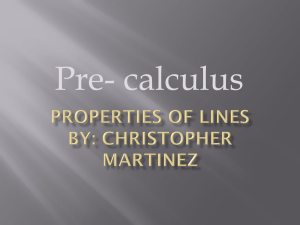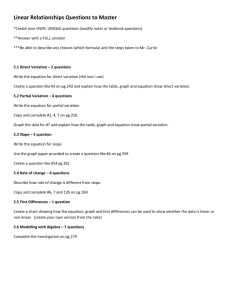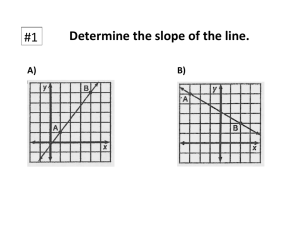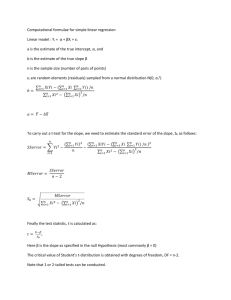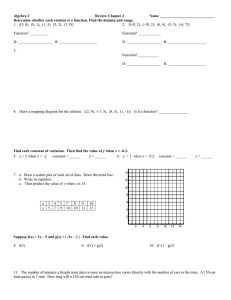LECTURE 3: SLOPE FIELDS September 08, 2014 Z
advertisement
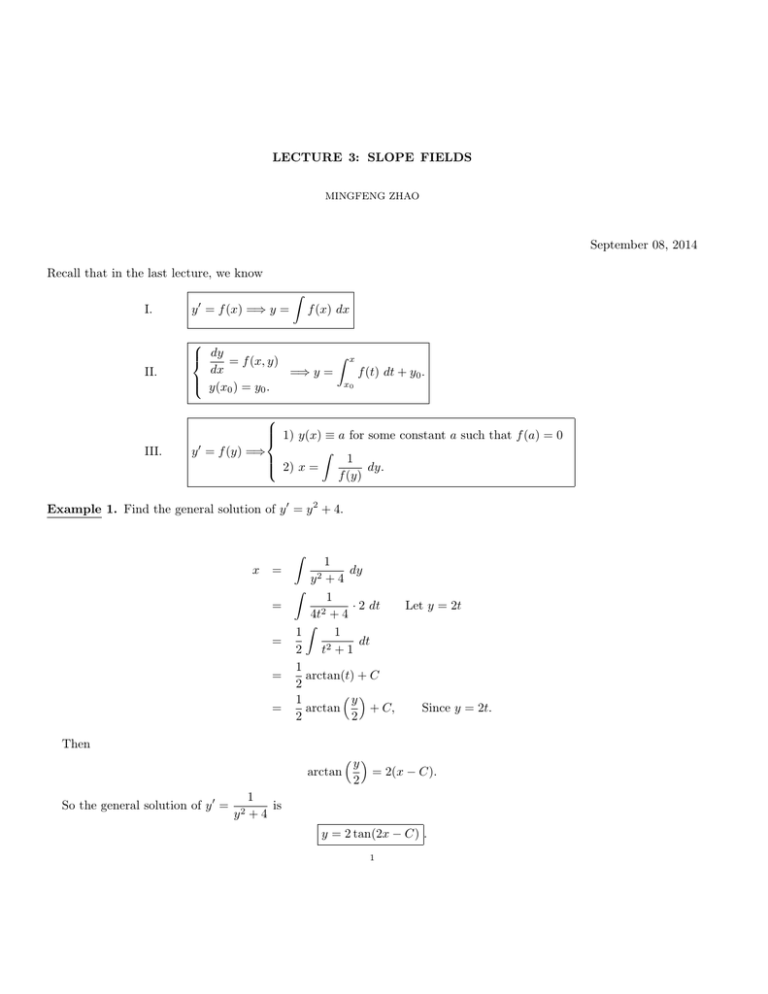
LECTURE 3: SLOPE FIELDS
MINGFENG ZHAO
September 08, 2014
Recall that in the last lecture, we know
Z
I.
y 0 = f (x) =⇒ y =
II.
Z x
dy = f (x, y)
dx
=⇒ y =
f (t) dt + y0 .
x0
y(x0 ) = y0 .
III.
1) y(x) ≡ a for some constant a such that f (a) = 0
0
Z
y = f (y) =⇒
1
dy.
2) x =
f (y)
f (x) dx
Example 1. Find the general solution of y 0 = y 2 + 4.
Z
x
=
=
=
=
=
1
dy
+4
Z
1
· 2 dt
Let y = 2t
2
4t + 4
Z
1
1
dt
2
2
t +1
1
arctan(t) + C
2
y
1
arctan
+ C,
Since y = 2t.
2
2
y2
Then
arctan
So the general solution of y 0 =
y2
y
2
= 2(x − C).
1
is
+4
y = 2 tan(2x − C) .
1
2
MINGFENG ZHAO
DIRECTION/SLOPE FIELDS
Definition 1. The direction/slope field of y 0 = f (x, y) is a picture on the plane such that for each point (x, y) on the
plane, one draws a short line segment with slope f (x, y) at the point (x, y).
To draw the slope field of y 0 = f (x, y):
1) select points in the xy-plane,
2) compute the numbers f (x, y) at the selected points (x, y),
3) at each selected point (x, y), draw a short tangent line whose slope is f (x, y).
Example 2. y 0 = 3x2 . (Recall that the general solution is: y = x3 + C.)
Figure 1. Slope field of y 0 = 3x2 with graphs of solutions satisfying y(0) = 0, and y(0) = ±1
LECTURE 3: SLOPE FIELDS
3
Remark 1. The slope field of y 0 = f (x) have the same direction/shape vertically.
Example 3. y 0 = −y. (Recall that the general solution is: y = Ce−x .)
Figure 2. Slope field of y 0 = −y with graphs of solutions satisfying y(0) = ±2, and y(0) = ±3
Remark 2. The slope field of y 0 = f (y) have the same direction/shape horizontally.
Example 4. y 0 = xy. (In Lecture 4, we’ll see that the general solution is: y = Ce
x2
2
.)
Figure 3. Slope field of y 0 = xy with graphs of solutions satisfying y(0) = ±0.2, and y(0) = ±1
4
MINGFENG ZHAO
Remark 3. For the directions of the short tangent line segment:
• “/” means positive slope
• “\” means negative slope
• “−” means zero slope
• “|” means infinity slope.
EXISTENCE & UNIQUENESS
Question 1. For the initial value problem:
y 0 = f (x, y)
f (x ) = y .
0
0
1) Does a solution exist?
2) Is the solution unique if it exists?
The answer to Question 1 really depends on the smoothness of f with respect to x and y.
1
Example 5 (Non-existence). Can you find a solution to y 0 = for y(0) = 0?
x
1
The general solution to y 0 = is:
x
y = ln |x| + C.
1
for y(0) = 0 exists, say g(x) is a solution. Then g(x) = ln |x| + C for some constant C, but
x
which is not defined at x = 0. Hence
If the solution to y 0 =
The solution to y 0 =
1
for y(0) = 0 does NOT exist.
x
2
Example 6 (Non-uniqueness). y 0 = 3y 3 , y(0) = 0.
1) y1 (x) ≡ 0 is a solution.
2) Let y2 (x) = x3 , then y2 (0) = 0, and
y20 (x) = 3x2 ,
2
2
3y 3 = 3(x3 ) 3 = 3x2 = y20 (x).
In summary,
p
Both y1 and y2 are solutions to y 0 = 2 |y|, y(0) = 0 .
LECTURE 3: SLOPE FIELDS
5
p
Example 7 (Non-uniqueness). y 0 = 2 |y|, y(0) = 0.
1) y1 (x) ≡ 0 is a solution.
x2 ,
if x ≥ 0
2) Let y2 (x) =
, then y2 (0) = 0 and
−x2 , if x < 0.
2x,
y20 =
−2x,
if x > 0
.
if x < 0.
So
p
y20 = 2 |y2 |,
for all x 6= 0.
On the other hand,
lim
h&0
h2
y2 (h) − y2 (0)
= lim
= lim h = 0
h&0 h
h&0
h
y2 (h) − y2 (0)
−h2
= lim
= lim −h = 0.
h%0
h%0
h%0
h
h
p
p
So y20 (0) exists and y20 (0) = 0 = 2 |y2 (0)|. Hence, y2 is also a solution to y 0 = 2 |y|, y(0) = 0.
lim
In summary,
p
Both y1 and y2 are solutions to y 0 = 2 |y|, y(0) = 0 .
Theorem 1 (Picard’s Theorem on Existence and Uniqueness). If f (x, y) is continuous with respect to x and y, and
∂f
(x, y) exists and is continuous near some (x0 , y0 ), then a solution to
∂y
y 0 = f (x, y),
y(x0 ) = y0 ,
exists for some small interval containing x0 , and is unique.
In Theorem 1, that solution is called a local solution on that small interval containing x0 . In this course, we always
say that the domain of a function should be an interval.
Remark 4. Mathematically, the proof of Theorem 1 is to find the fixed point of the following integral equation:
Z x
y(x) = y0 +
f (t, y(t)) dt,
x0
which is done by Picard’s iteration method:
0) y0 (x) ≡ y0
Z
x
1) y1 (x) = y0 +
f (t, y0 (t)) dt
x0
6
MINGFENG ZHAO
x
Z
2) y2 (x) = y0 +
f (t, y1 (t)) dt
x0
..
.
Z
x
n) yn (x) = y0 +
f (t, yn−1 (t)) dt
x0
Finally, we need to prove {yn (x)} will uniformly converge to some continuous function y(x) on a small interval
containing x0 , then this function y(x) is just the solution.
Example 8. Let f be continuous, the solution to y 0 = f (x), y(x0 ) = y0 is given by:
Z
x
f (t) dt + y0 .
y=
x0
Example 9. Let f be differentiable and f 0 be continuous. Assume f (a) = 0 and y(x) satisfies y 0 = f (y) and y(x0 ) = a.
Then
y(x) ≡ a .
Example 10. Is it possible to solve the equation y 0 = y
p
|x| for y(0) = 0? Is the solution unique?
p
In Lecture 4, we will see that the general solution to y 0 = y |x| is:
2
3
y = Ce 3 |x| 2 .
It’s easy to see that
y(x) ≡ 0 is a solution to y 0 = y
Let f (x, y) = y
p
p
|x| for y(0) = 0 .
|x|, then f (x, y) is continuous with respect to x and y, and
p
∂f
(x, y) = |x|is continuous at (0, 0).
∂y
So
y(x) ≡ 0 is the only solution to y 0 = y
p
|x| for y(0) = 0 .
Example 11. Let A be a constant, solve y 0 = y 2 , y(0) = A.
Since the general solution to y 0 = y 2 is:
Either y(x) ≡ 0, or y =
1) If A = 0, then y(x) ≡ 0.
1
.
C −x
LECTURE 3: SLOPE FIELDS
2) If A 6= 0, then A = y(0) =
7
1
1
, that is, C = . Hence
C
A
1
.
y= 1
−
x
A
For the domain of the solution:
1
– If A > 0, then x < .
A
1
– If A < 0, then x > .
A
In summary,
y(x) ≡ 0,
if A = 0
1
1
, for all x < , if A > 0
y(x) = 1
A
A −x
1
1
, for all x > , if A < 0.
y(x) = 1
A
−
x
A
Department of Mathematics, The University of British Columbia, Room 121, 1984 Mathematics Road, Vancouver, B.C.
Canada V6T 1Z2
E-mail address: mingfeng@math.ubc.ca
